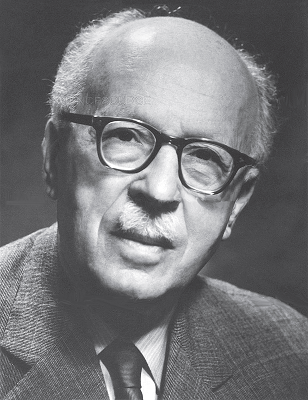All his life, the great Croatian-Swiss scientist Leopold Ruzicka maintained an enormous interest in the chemical processes of nature. His experimental work reveals his single-minded preoccupation with the chemistry of natural products. In 1939, he was awarded the Nobel Prize in Chemistry for his pioneering work on polymethylenes and terpenes (odorous chemicals produced by animals and plants).
A natural product organic chemist par excellence
Leopold Ruzicka began painstakingly investigating natural odorous compounds in 1916, and in a few years, made the ground-breaking discovery that the molecules of the naturally occurring musk perfumes—muscone (obtained from the musk deer) and civetone (sourced from the civet cat)—contain rings of fifteen and seventeen carbon atoms respectively. His discovery created a sensation in the field of organic chemistry because at that time it was believed that molecules with rings of more than eight carbon atoms would be too unstable to exist.
Ruzicka’s discovery was also a heroic one, achieved in the face of great experimental challenges, considering that he investigated the structure of molecules using only the chemical methods known at that time. In contrast, for work of a similar nature, since the last few decades, chemists have been using more advanced analytical methods such as spectroscopy and X-Ray analysis.
And not only did the discovery of the structure of muscone and civetone pave the way for further research on such large ring compounds, Ruzicka himself went on to synthesise these two odorous substances in his laboratory. This achievement caught the interest of the perfumery industry. For thousands of years, musk had been extensively used for preparing perfumes. But, for obtaining natural musk, large numbers of the endangered musk deer had to be killed. Today, thanks to Ruzicka’s research work, the perfume industry almost exclusively uses synthetically prepared muscone.
Early life and career
Leopold Ruzicka was born on 13 September, 1887, in Vukovar, a small town on the Danube in present-day Croatia. His father was Croatian while his mother was of German descent. The frequent riots and political unrest in his home country, made him move to Germany to study at the Karlsruhe Institute of Technology for his university education. Here, he completed his laboratory courses in less than two years and then immediately commenced his doctoral work on ketenes, studying under the young professor Hermann Staudinger who, at 27, was only 6 ½ years older than him.
Ruzicka received his doctorate degree in 1910, and when Staudinger took up a new position at the Swiss Federal Institute of Technology in Zurich (ETH), Switzerland in 1912, he joined him there as his assistant. The two of them then began research work on pyrethrins, natural insecticides extracted from chrysanthemum flowers. By 1916, Ruzicka decided to work in a research field of his own choice and commence his own scientific career. He was happy to be able to spend time from morning to night at his laboratory bench. But, with his part-time teaching job at the University of Zurich being as good as an honorary job, to meet his living and laboratory expenses he had to seek industry collaboration. He received Swiss citizenship in 1917, and was appointed as a professor at ETH few years later.
In the beginning, Ruzicka had to make time for teaching and researching simultaneously at ETH and the University of Zurich. From1926 till 1929 he taught as Professor of Organic Chemistry at the University of Utrecht in the Netherlands, but chose to return to ETH in 1929 on being offered the position of Director of its analytical laboratory.
Being keenly interested in terpene chemistry, Ruzicka had first turned to the perfumery industry for financial backing of his research work. But, following two unsatisfactory attempts at industrial collaboration, finally in 1921, he entered into a successful partnership with the Geneva perfume manufacturers Chuit, Naef & Firmenich. After focusing on investigating natural odours from 1916 to 1924, Ruzicka then moved on to researching other large ring molecules like steroids and hormones and by the mid-1930s unravelled the molecular structure of the male sex hormones—testosterone and androsterone and then went on to synthesise them. At that time, his laboratory was among those at the forefront of hormone research in the world.
Resolute opposition to the Nazi regime
A few years later, when the Nobel Prize in Chemistry was conferred on Leopold Ruzicka, World War II had just broken out. Though uninterested in politics during his youth, Ruzicka now openly professed his opposition to Hitler’s government, going as far as to helping many Jewish scientists to escape from Nazi-occupied countries to neutral Switzerland, and even employing some of them in his laboratory. Ruzicka was also one of the founding members of the Swiss-Yugoslav Relief Society.
A lover of science and art
During the war years, with many works of art being sold at slashed-down prices, Ruzicka, who had for long nurtured an interest in 17th century Dutch paintings, invested a considerable amount of the money he earned from royalties on patents into establishing a foundation for a small personal collection of exquisite Dutch paintings at the Kunsthaus in Zurich. He had to take a break from his scientific work and spenr time on travel to acquire the paintings.
The Ruzicka collection at the Kunsthaus that includes works by renowned artists such as Adriaen Brouwer, Jan Brueghel, Rembrandt, Rubens, and many others, attracts a large number of art lovers.
Ruzicka was also an ardent gardener, devoting a lot of time to tending to his plants. Another hobby of his was colour photography. His great fondness for paintings and photography seems quite interesting considering he was severely colour-blind, finding it difficult to distinguish the colour red. They say his friends would joke about this shortcoming suggesting that it explained his leftist political views.
A return to chemistry
Towards the beginning of the 1950s, there were important changes in Ruzicka’s personal and professional life. In 1950, he and his first wife Anna, whom he had married in 1912, got divorced after a childless marriage. The following year, at the age of 64, he married Gertrud Acklin, the mother of a grown-up son.
Around this same time, he returned to the field of chemistry after a break of a few years, to find that the methods and techniques for studying molecular structures had fundamentally changed by now. Researching by purely chemical methods had been replaced by physical methods like molecular spectroscopy and X-ray crystallographic analysis. Realising the advantages of adopting these modern methods, he acquired the necessary instruments and equipment and saw to it that trained people were available for taking care of and maintaining them.
Also, Ruzicka’s interest had now shifted to biochemistry, particularly to the biogenesis of terpenes and steroids, substances on which he had carried out pioneering chemical research in the past. This phase in his professional life marked another major achievement on his part. While researching terpenes earlier, he had extensively applied the then in use ‘Isoprene Rule’. Now, over a decade later, in 1953, he proposed his own ‘Biogenetic Isoprene Rule’ that replaced the former rule and soon received universal acceptance.
Till this time, biochemistry was being taught in Switzerland mostly as a preliminary and ancillary discipline. Ruzicka vigorously campaigned for the establishment of a separate Chair and laboratory of biochemistry at ETH. His efforts finally met with success in 1956, just before he retired.
Awards and recognitions
As a tribute to Ruzicka, when he retired in 1957 at the age of 70, the Swiss chemical industry contributed towards establishing the Ruzicka Prize at ETH. Each year, this prize is awarded for outstanding work done by young Swiss chemists or chemists working in Switzerland.
In 1974, Ruzicka’s native Yugoslavia honoured him with the Order of the Yugoslav Flag with Golden Wreath. In his home town Vukovar, the house where he was born has been converted into a modest-size Ruzicka Museum.
Apart from the Nobel Prize, some of the other major honours conferred on him include the Marcel Benoist Prize—Switzerland’s highest scientific award, eight Honorary Doctorates, and Honorary Fellowships of a number of reputed societies. He was also an honorary member of the American Academy of Arts and Sciences.
A prolific writer, he continued writing even in his old age, his 583 publications spanning a period of sixty years. Most of these however were published between 1930 and 1950.
Leopold Ruzicka died on 26 September, 1976 at the age of 89 in Mammern in Switzerland, a village on Lake Constance. He succumbed to the after-effects of a surgery he had undergone.
When America’s Harvard University awarded Ruzicka an honorary doctorate in 1936, Dr. James B. Conant, Harvard’s President, had aptly lauded him as, “A chemist daring in his attack, brilliant in his methods, successful in his interpretations of the architecture of nature’s baffling compounds.” It was a worthy tribute to one of the great men of science.
References
1. NobelPrize.org: Leopold Ruzicka – Biographical – Nobel Media AB 2014, https://www.nobelprize.org/nobel_prizes/chemistry/laureates/1939/ruzicka-bio.html
2. Soylent Communications: Leopold Ruzicka – http://www.nndb.com/people/427/000100127/
3. University of Zurich: Leopold Ruzicka – Nobel Prize in Chemistry 1939 – http://www.uzh.ch/en/about/portrait/nobelprize/ruzicka.html
4. Michigan State University, Department of Chemistry: Leopold Ruzicka – https://www.chemistry.msu.edu/faculty-research/portraits/leopold-ruzicka/
5. Vladimir Prelog, Oskar Jeger: Leopold Ruzicka, 13 September 1887 – 26 September 1976 – Biographical Memoirs of Fellows of the Royal Society, 26, 411-502, 1980
6. Albert Eschenmoser: Leopold Ruzicka – From the Isoprene Rule to the Question of Life’s Origin – Chimia44 (1990) Nr. 1-2 (January-February).
































